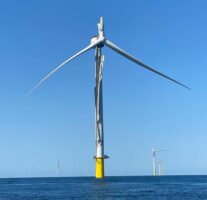China PV giant Trina Solar has thrown its weight behind an Antipodean study into how modern, single-axis tracking solar technology performs compared older systems out in the wild – and which crops might be the best to plant beneath tracking panels and how to help them thrive.
Trina, which notched up more than 190GW of worldwide, cumulative PV shipments by the end of 2023, announced this week that it is partnering in the new study at Australia’s inaugural tracker testbed at Hills Educational Foundation (HEF) near Brisbane.
The project, also involving the Queensland University of Technology and construction and civil engineering services firm Diona, measures the performance of a modern solar farm against an eight-year-old counterpart, using Trina Solar’s Vertex DEG19 bifacial modules on single-axis Vanguard 2P trackers.
Solar tracking technology like Trina’s Vanguard 2P changes the angle of a PV project’s panels from morning to night, following the path of the sun from the east in the morning until till it goes down in the west.
This not only increases the generation output of solar farms, but also makes their energy management easier by leveling out the output across the day and avoiding big spikes in the middle. All up, they can significantly improve the levelised cost of energy of a large-scale solar project.
Edison Zhou, Trina’s head of Australia, New Zealand and the Pacific Islands, says the study will help Australian solar asset owners to determine whether or not it is economically viable to replace older panels with the new ones.
“It will also determine how to grow crops under solar modules and trackers and provide insight into how to maximize the albedo effect… to boost power generation,” Zhou said at a briefing in Sydney on Tuesday.
The study’s investigations into the albedo effect, or the impact of reflected sunlight on solar generation, will experiment with materials like recycled tin cans, pale-colored ground covers, and cement sheeting to see how these might enhance light reflectivity for increased energy yield.
On the crops side of the equation, the HEF project plans to use white-painted offcuts of shipping containers for cultivating mycelium, a protein-rich fungus widely recognised as a valuable feedstock.
The study, and Trina’s backing of it, comes at an important time for solar in Australia, with large-scale PV projects increasingly competing for space in regions traditionally used for farming – and for space in the hearts and minds of regional communities.
While there is no shortage of sheep graziers who will sing the praises of agrivoltaics, far right Coalition politicians and some minor parties are fanning concerns about land acquisition and clearance for renewables and transmission projects and manufacturing a battle of ‘agriculture vs renewables.’
“Agrivoltaics is something that Australia’s farming community is interested to explore,” says Joseph Marinov, CEO Hills Educational Foundation.
“Creating an environment conducive for crops to grow under the solar modules will help the country’s farmers to embrace renewable energy.”
Trina’s head of utility and commercial and industrial solutions in Asia Pacific, Andrew Gilhooly, says the work being done across the ditch in New Zealand – where all usable land is at a premium, both for farming and renewables – augers well for agrivoltaics.
“I was over in New Zealand last week at the ribbon cutting for the first utility scale solar farm [there] … and they had the sheep running through the paddocks,” he told RenewEconomy this week.
“There was actually a pronounced uptick in grass growth underneath the trackers as opposed to the grass that’s getting blasted by the full sun every day.
“The sheep loved it because they were under the trackers and getting some shelter …so the next step will be the initiatives like we’re taking at Hills to understand the types of cropping that can be done for arable as well as pastoral agriculture.”
James Duckworth, who with Smart Commercial Solar is currently working with Trina Solar on construction of one of Australia’s pioneering community solar farms in Goulburn in NSW, says he, too, has seen the positive impact solar trackers can have on farmland.
“We have two projects, currently, with Trina trackers that have sheep grazing and, before the sheep came in, we saw an enormous difference in grass height.
“So where the tacker was, it was literally double the grass height, because you had shading and rainfall dependent upon which angle the modules are tilted. You have good light access but not so much … that any of the excess moisture was turning to vapor and going into the atmosphere.
“And sheep loved it, also, because they can just move along and stay in the shade on those really hot days.
“So it definitely is very compatible with sheep grazing …and you actually get a greater yield of grass so therefore your stocking density [of sheep] can be higher,” Duckworth said.










